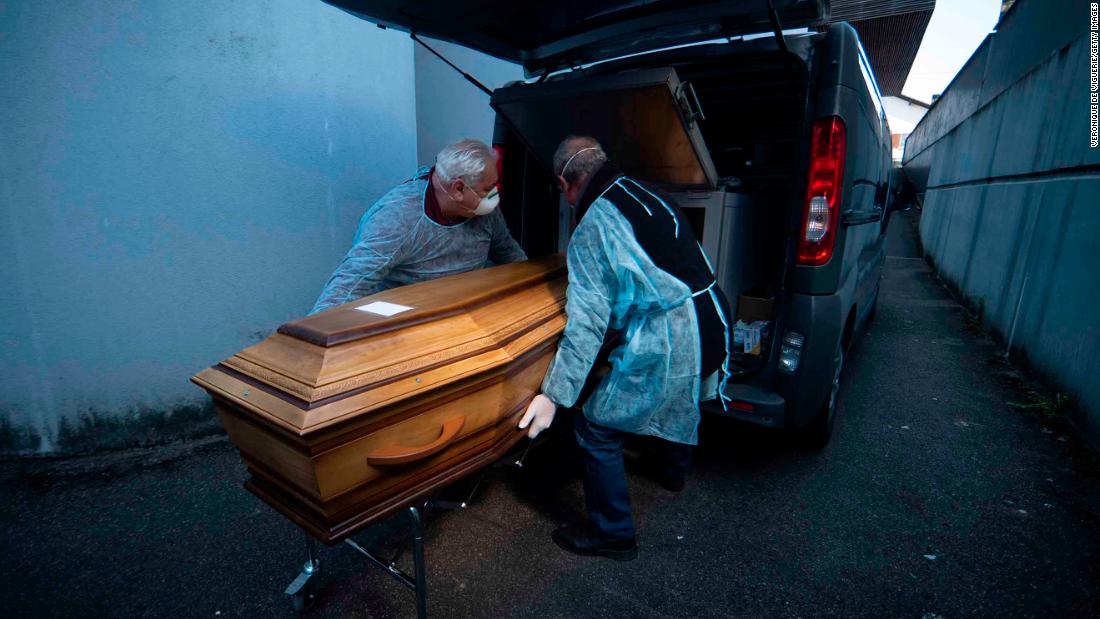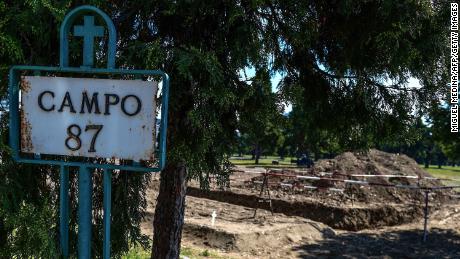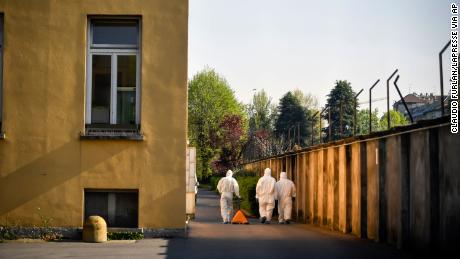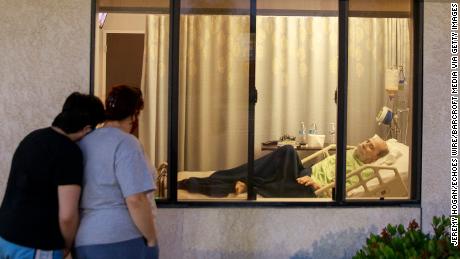The world sacrificed its elderly in the race to protect hospitals. The result was a catastrophe in nursing homes

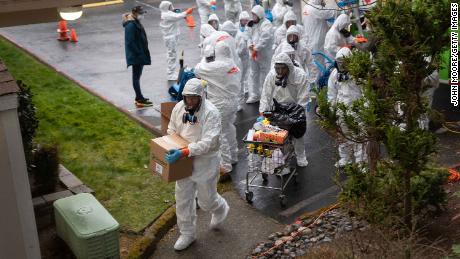
A cleaning crew enters the Life Care Center on the outskirts of Seattle, Washington on March 12.
Early struggles
Researchers based at the London School of Economics (LSE) created the Long-Term Care responses to Covid-19 (LTCcovid) group with its International Long Term Care Policy Network (LTCPN). LTCcovid is a global network of academics and experts in the field who gather and analyze official data from around the world, and found that many countries were seeing high rates of severe infections and deaths in care homes.
Comparing death tolls can be difficult: some countries have separate data covering elderly care homes, while others include facilities for those with disabilities. Some countries do not include in their data those residents who die in hospitals, some have regional variation, and some have no data at all.
“France, Spain, and Italy were overwhelmed by the virus very quickly,” said lead LSE researcher Adelina Comas-Herrera, from the university’s care policy and evaluation center. “They were the first countries in Europe to have these problems on a big scale. And I think they offered a lot of lessons that ideally could have been learned in other European countries.”
Prime Minister Giuseppe Conte’s spokesperson told CNN that he hasn’t made a statement on care homes.
A similar story played out in France, where coronavirus fatalities among care home residents in all settings make up more than half of all coronavirus deaths recorded as of May 18, according to health ministry data used in the LTCcovid report.
Data in Spain is inconsistent, with some regions including facilities for people of all ages with disabilities. The number of confirmed coronavirus deaths in care homes as of May 10 was 9,642, 30.2% of 31,889 coronavirus deaths in total, according to health ministry data cited in the LSE report.

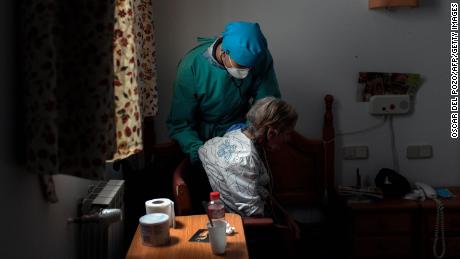
A doctor examines an isolated resident at a nursing home in Madrid, Spain on April 24.
Italy, France and Spain
On April 1, a source at Lombardy’s health department — who requested anonymity because they had not sought authorization to speak to media — told CNN that the department had prioritized testing new admissions to hospitals and medical facilities over testing existing patients such as those at care homes.
The Lombardy government told CNN it is not giving interviews on “the nursing home issue,” due to an ongoing independent investigation into the region’s high number of care home deaths that it launched on April 7.
Jean-Pierre Riso, president of the National Federation of associations of directors of establishments and services for the elderly (Fnadepa), told Reuters that the delay “contributed to the spread of the virus in nursing homes,” but there is no evidence of a direct link between the requisition policy and care home deaths.
The French Health Ministry did not respond to CNN’s request for comment.

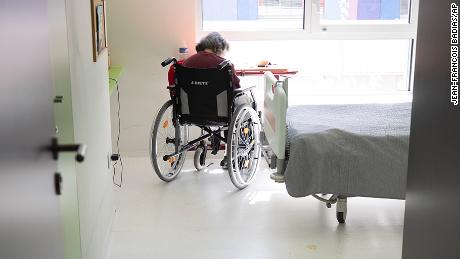
A resident sits in her room after being tested with Covid-19 in a nursing home in Bergheim, eastern France, on April 14.
The care home guidelines did not specify whom to contact in the event of suspected cases, staff shortages or lack of PPE.
Care homes in Spain do not have regular contact with governing administrations, and workers had to call the general emergency number to report potential infections to staff who were not specifically trained in care home needs.
The lack of communication heightened the impact of PPE shortages, low priority given to symptomatic residents for hospitalization and lack of medical support, said the research.
‘Toughest period I’ve seen’
Many countries seemed slow to learn the care home lessons from nations affected early in the pandemic.
However, while Johnson said in a news conference on March 16 that “we don’t want to see people unnecessarily visiting care homes,” homes were not told to ban visits ahead of the national lockdown on March 23.
A DHSC spokeswoman told CNN: “The initial advice accurately reflected the situation at the time when there was no community transmission, meaning there was a limited risk of the infection getting into a care home.”
“Once there was evidence of widespread transmission and we moved into the ‘delay’ phase, new guidance was immediately put in place.”
She said the DHSC was prioritizing testing in care homes and had provided £3.2 billion ($3.9 billion) to local authorities to ease pressure on services including care homes, as well as an additional £600 million ($730 million) for homes last week. “Since the start of this pandemic we have worked to ensure our care homes and frontline care workforce get the support they need. Almost two thirds of care homes have not had an outbreak and deaths in all settings, including care homes, are falling.”
However, Nicola Richards, who runs three Palms Row Health Care homes in Sheffield, said her facilities had faced problems. The homes are privately run, but many residents’ places are government-funded.
Some hospitals had sent residents back to the homes without a coronavirus test and staff had to isolate alongside residents, with PPE in short supply, Richards said. She said it felt “immoral” asking “terrified” staff — some on the UK national minimum wage of £8.72 ($10.66) per hour — to look after people with Covid-19. She said some of her staff had been in tears, adding that she had not yet seen any of the government’s emergency funding to help with spiraling costs.
Mike Padgham, the managing director of St. Cecilia’s care home in Scarborough, in northern England, said 19 residents out of 110 had died in the past two months, but only five were confirmed Covid-19 deaths — the rest were “undetermined,” he said. He said he thought there had been “slight under-reporting” of deaths in the UK because of a lack of testing, and said the situation had been “harrowing.”
“I’ve been in the business of care homes for close to 30 years, and it’s the toughest period that I have seen in all that time,” he told CNN. He said guidance from the government had been “contradictory” and funding hadn’t reached many facilities, which were worried about their future.
It says most government estimates are too low because of problems with identifying cause of death. The researchers said that comparing deaths this year to deaths in previous years (“excess mortality”) is the best measure, and includes deaths that are indirectly caused by the virus.
Silent suffering
There were similar issues throughout the sector — people with chronic conditions living in close proximity; caregivers spreading infection between residents and facilities; and staff shortages due to sickness, isolation and low pay.
A seniors’ home in Montreal, Canada showed just how catastrophic such problems can be. A criminal investigation was launched after 31 residents died at Herron Seniors’ Residence in less than a month, five of them confirmed Covid-19 cases. Quebec officials said most of the staff had abandoned the home and residents were found unfed and unchanged in what looked like a case of gross negligence.
The investigation is still ongoing. The home declined to comment when approached by CNN in mid-April because of pending investigations and lawsuits.
LTCcovid’s report found that 3,890 of Canada’s 4,740 coronavirus-linked deaths took place among care home residents as of May 8, or 82%, and Health Canada told CNN the percentage was nearly 80% on May 19. Canada’s largest province, Ontario, has announced an independent inquiry.
Care homes are typically paid for through a combination of government funding and private fees, the LSE noted, meaning there is a huge variation in quality of care and that people of low socio-economic status fare the worst. This has only been exacerbated by the crisis, it said.
Lessons from SARS
Comas-Herrera told CNN that nations that had more successfully controlled Covid-19 overall had typically done better with care homes, too.


Care home resident Phyllis Padgham, 93, says she’s felt worried and lonely since the outbreak began.
They moved swiftly to lock down homes and introduce measures such as widespread testing, PPE, temperature checks and strict isolation zones. In South Korea it was common for staff to isolate with residents and be replaced every two weeks.
Hong Kong says it has not had a single infection in a care home, and only four deaths and just over 1,000 cases in total. In Singapore, just two of 18 deaths have taken place among care home residents.
“There’s been a lot of focus in hospitals and focus on community transmission, but not in care homes. And I think that reflects the low status that the care sector has in many countries,” said Comas-Herrera.
The authors of the JAMA report on Seattle write that: “Although many prefer not to think about nursing homes, they are a critical safety net for frail older adults and part of the fabric of our society.”
Phyllis Padgham, a 93-year-old resident at St. Cecilia’s nursing home in the UK and mother to the manager, told CNN she was looking forward to going for walks and seeing family once the world is safe again.
“I’m always worried,” she said. “It’s not nice for hospitals or nursing homes. I just want it to come to an end.”
CNN’s Paula Newton, Benjamin Berteau, Sophie Stuber, Valentia DiDonato, Nicola Ruotolo and Claudia Rebaza contributed reporting.
![]()


